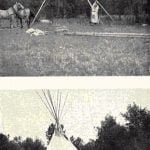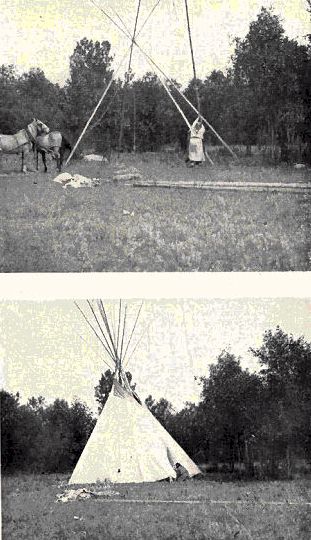
One of the most characteristic features of Plains Indian culture was the tipi. All the tribes of the area, almost without exception, used it for a part of the year at least. Primarily, the tipi was a conical tent covered with dressed buffalo skins. A carefully mounted and equipped tipi from the Black-foot Indians stands in the center of the Plains exhibit. Everywhere the tipi was made, cared for, and set up by the women. First, a conical framework of long slender poles was erected and the cover raised into place. Then the edges of the cover were staked down and the poles supporting the “ears” put in place. The “ears” are wings, or flies, to keep the wind out of the smoke hole at the top; they were moved about by the outside poles. The fire was built near the center and the beds spread upon the ground around the sides. The head of the family usually sat near the rear, or facing the door.
While in essential features the tipis of all Plains tribes were the same, there were nevertheless some important differences. Thus, when setting up a tipi, the Blackfoot, Crow, Sarsi, Hidatsa, Omaha, and Comanche first tie four poles as a support to the others; while the Teton-Dakota, Assiniboin, Cheyenne, Gros Ventre, Arapaho, Kiowa, Plains-Cree, Mandan, and Pawnee use three, or a tripod foundation. For the remaining tribes, we lack data, but it seems safe to assume that they follow one or the other of these methods. The three-pole foundation gives the projecting tops of the poles a spiral appearance while the four-pole beginning tends to group them on the sides. Thus, to a practiced eye, the difference is plain. The covers, ears, doors, etc., are quite similar throughout. The shapes of tipis, however, show some differences. Thus, the Cheyenne prefer a wide base in proportion to the height while the Arapaho prefer a narrow base. Again, the Crow use very long poles, the ends projecting out above like a great funnel.
It is important to note that the use of the tipi is not confined to the plains. The Ojib way along the Lakes used it, but covered it with birch bark as did also many of the Cree and tribes formerly established in eastern Canada and New England. Even the Eastern Dakota in early days used birch bark for tipi covers. A tipi-like skin-covered tent was in general use among the Indians of Labrador and westward throughout the entire Mackenzie area of Canada. To the west, the Plains tipi was found among the Nez Perce, Flathead, Cayuse, and Umatilla; to the southwest, among the Apache. It is well nigh impossible to determine what tribes first originated this type of shelter, though a comparison of the details of structure might give some definite clues. Yet, one thing is clear; viz., that it was especially adapted to the roving life of the Plains tribes when pursuing the buffalo.
Earth Lodges
Before going further, we must needs recall that the tipi was not the only type of shelter used by these Indians. The Mandan, Hidatsa, and Arikara lived in more or less permanent villages of curious earth-covered lodges. The following description of a Hidatsa house may serve as a type:
On the site of a proposed lodge, they often dig down a foot or more in order to find earth compact enough to form a good floor; so, in some lodges, the floors are lower than the general surface of the ground on which the village stands. The floor is of earth, and has in its center a circular depression, for a fire-place, about a foot deep, and three or four feet wide, with an edging of flat rocks. These dwellings, being from thirty to forty feet in diameter, from ten to fifteen feet high in the center, and from five to seven feet high at the eaves, are quite commodious.
The frame of a lodge is thus made: A number of stout posts, from ten to fifteen, according to the size of the lodge, and rising to the height of about five feet above the surface of the earth, are set about ten feet apart in a circle. On the tops of these posts, solid beams are laid, ex tending from one to another. Then, toward the center of the lodge, four more posts are erected, of much greater diameter than the outer posts, and rising to the height of ten or more feet above the ground.

These four posts stand in the corners of a square of about fifteen feet, and their tops are connected with four heavy logs or beams laid horizontally. From the four central beams to the smaller external beams, long poles, as rafters, are stretched at an angle of about 30 with the horizon; and from the outer beams to the earth a number of shorter poles are laid at an angle of about 45. Finally a number of saplings or rails are laid horizontally to cover the space between the four central beams, leaving only a hole for the combined skylight and chimney. This frame is then covered with willows, hay, and earth, as before mentioned; the covering being of equal depth over all parts of the frame. (Matthews, 4-5).
Houses of approximately the same type were used by the Pawnee, Omaha, Ponca, Kansa, Missouri, and Oto. The Osage, on the other hand, are credited with the use of dome-shaped houses covered with mats and bark, like the jib way and other Woodland tribes. The Hidatsa type of lodge is, unlike the tipi, definitely localized along the Missouri and the Platte, giving one the impression that it must have originated within this territory. The Omaha claim to have originally used tipis and to have learned the use of earth-lodges from the Arikara; likewise the Skidi-Pawnee claim the tipi as formerly their own dwelling. However, all these tribes used tipis when on summer and winter trips after buffalo (p. 21).
Some of the Eastern Dakota lived for a part of the year in rectangular cabins of bark and poles as did some of the Woodland tribes. On the west, an oval or conical brush or grass shelter seems to have preceded the tipi. The Comanche were seen using both this western type of brush lodge and the tipi in 1853. The Northern Shoshoni have also been observed with brush lodges and tipis in the same camp. These instances are probably examples of a transition in culture. Thus, we see how even among the less civilized peoples all are prone to be influenced by the culture of their neighbors and that in consequence, cultures grade into one another according to geographical relations. (The low earth-covered lodges are obscured by the poles of drying-frames. Morrow photo reproduced by F. N. Wilson.)
Another curious thing is that all the tribes raising maize used earth or bark houses, but as a rule lived in them only while planting, tending, and harvesting the crop. At other times, they took to tipis. Even in mid-winter the Omaha and Eastern Dakota lived in tipis.
A unique and exceptional type of shelter was used by the Wichita and the related Caddoan tribes of the Southeastern culture area. This is known as a grass lodge. It consists of a dome-shaped structure of poles thatched with grass and given an ornamental appearance by the regular spacing of extra bunches of thatch. Formerly, each of these houses had four doors, east, west, north, and south, and four poles projected from the roof in the respective directions.


